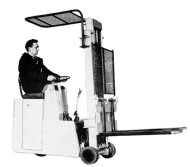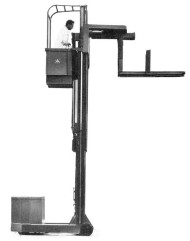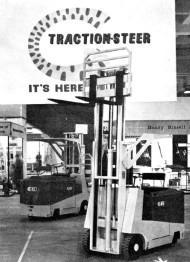 Warehouse & Logistics News is proud to bring you the forty-ninth instalment in our exclusive series on the history of the fork lift truck, the machine that over the decades has revolutionised the face of materials handling around the world.
Warehouse & Logistics News is proud to bring you the forty-ninth instalment in our exclusive series on the history of the fork lift truck, the machine that over the decades has revolutionised the face of materials handling around the world.
Our writer is James Brindley, an acknowledged authority on fork lift trucks. James’s distinguished career has involved engineering and management roles with BT Rolatruc and serving as a Director of the Fork Lift Truck Association, before he set up the National Fork Truck Heritage Centre in 2004 as Britain’s first such collection open to the public.
The Heritage Centre continues to need your support in 2010, and if you or your company would like to help in any way, you can contact James on the number below. Now sit back and enjoy the latest part of this fascinating series.
Episode 49: 1965 – the innovation continues
During the spring of 1965 the Harborough Construction Company (Harbilt) launched a one-ton battery powered forklift truck onto the British market. This three wheeled, sit-on counterbalance was the company’s first fork lift fitted with the ‘Rectacter’ resistance free speed controller. In simple terms, the system operated by smoothing out the power surges between contactor steps. This involved installing a number of diodes in the circuit so that the battery could be connected to the drive motor using a system of series and parallel connections.
 More widely known in the road vehicle market, this company started production in 1921. Its main products were platform trucks and milk floats although one of the company designers, Percy Clulow, was credited with designing a wringer mangle for home laundry use in 1945. Their first forklift truck, mentioned in Fork Truck History Episode 22 (W & LN), began production in 1955.
More widely known in the road vehicle market, this company started production in 1921. Its main products were platform trucks and milk floats although one of the company designers, Percy Clulow, was credited with designing a wringer mangle for home laundry use in 1945. Their first forklift truck, mentioned in Fork Truck History Episode 22 (W & LN), began production in 1955.
Sad news this year included the announcement that one of the industry’s leading businessmen, John R. Sharpe, had died. He was not only one of the founders of the Lansing Bagnall Company but also one of the directors responsible for the formation of the Institute of Materials Handling and the Federation of Association of Material Handling Manufacturers. He received a CBE in the 1963 Birthday Honours List.
In France the Salon International Show in Paris gave Fiat not only the opportunity to demonstrate its new OM forklift truck but also a new design in lifting attachments. The original innovation was no doubt to be credited to Lansing Bagnall, as used on the man up FAES1 back in 1964. The concept was soon to be incorporated on their narrow aisle production model, designated as the FAER 5.
Known today by many as the trilateral head, it was to become one of the leading inventions in narrow aisle technology.
Though the two manufacturers’ products were different in appearance, they were broadly similar in performance. However it could be said that in the counterbalance version the customer had more choice when buying a single truck that could cover use in a warehouse environment as well as being able to handle the more aggressive outdoors parts of the application.
Other brief but important news in the latter part of 1965 was the demise of the British manufacturer Leverstart Ltd, which ceased all production of its Electromatic fork lift trucks. These had been manufactured since 1954.
January 1966 began with the launch of Montgomery Reid’s new counterbalance models MR10, MR15, MR20, MR30 and MR45, battery powered forklifts with traction steer drive. This was a sales feature for all three and four wheeled trucks in the range. Although the principle of traction steer was not new, it was presented here in an improved and developed design especially for the larger capacity four wheeled models.
 These models had an independent drive motor mounted on each of their twin steering wheels, and the steering was joined together by a connecting rod and sliding bar assembly. This set up gave a 180-degree turning lock in both directions and was linked to a central control system. This governed the differential speeds on each wheel, appropriate to the degree of turn. In the language of the driver, this eliminated the uncomfortable sensation of back end swing. All five trucks in the range were available with Thyristor or Carbonstat speed control.
These models had an independent drive motor mounted on each of their twin steering wheels, and the steering was joined together by a connecting rod and sliding bar assembly. This set up gave a 180-degree turning lock in both directions and was linked to a central control system. This governed the differential speeds on each wheel, appropriate to the degree of turn. In the language of the driver, this eliminated the uncomfortable sensation of back end swing. All five trucks in the range were available with Thyristor or Carbonstat speed control.
During April 1965 the Conveyancer – Raymond partnership launched the ‘Walkie reach fork truck. Main features included a dual voltage electrical system on the speed control giving good battery economy (12 volts for 1st and 2nd speeds, and 24 volts for its 3rd speed.) It also had separate hydraulic systems for reach and lift operations. Load capacity was 2,500lbs to 148 inches, and it was capable of being operated in an aisle width of only 84 inches.
To be continued
By James Brindley, Director, National Fork Truck Heritage Centre.
If you would like to support the National Fork Truck Heritage Centre, please call James Brindley on 0780 195 4167




Comments are closed.